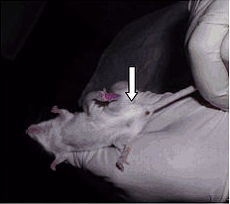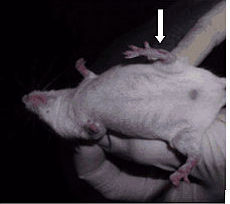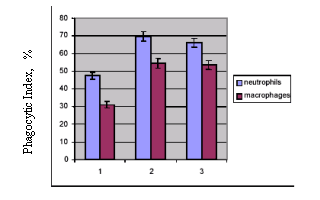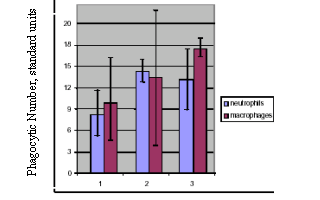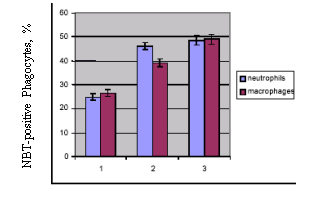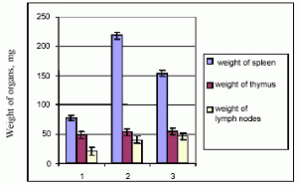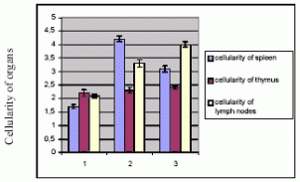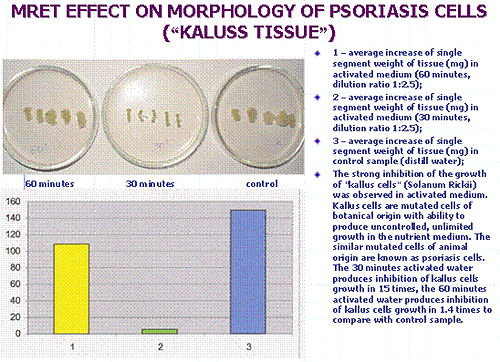
VISCOSITY TEST
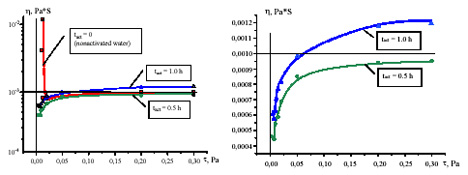
THE EFFECT OF MRET ACTIVATED MEDIUM ON CELL MORPHOLOGY
THE EFFECT OF MRET ACTIVATED WATER ON STAPHYLOCCOCAL INFECTION IN VIVO IN ANIMAL MODEL (ON THE CELLS OF IMMUNE SYSTEM)
The research was conducted at Kiyv National Shevchenko University, Ukraine on 400 mice. The mice-male of line BALB in the age of 11 – 13 weeks and of the weight 18 – 21 grams were used. In the process of investigation, all mice were divided into three groups. Prior to the inoculation of Staphylococcus aureus Wood-46 culture one group of mice consumed MRET water during 4 weeks (Group 1), another group consumed MRET water during 2 weeks (Group 2), the control group consumed non-activated ordinary distilled water. During the following 2 weeks of the experiment, the first two groups continued to consume MRET water and the control group consumed ordinary distilled water. The first line of experiments was conducted on 225 mice in order to analyze the persistence of pathogen in the homogenate of kidneys of mice comparing 5 groups of mice (two Group 1 and two Group 2 on 15 minutes and 30 minutes MRET activated water and Control). After preliminary experiments, the optimal 30 minutes MRET activated water (distilled) was chosen for the main line of investigation.
Results
1. Significant protective properties of MRET water.
The significant protective properties of MRET water were confirmed by substantial decrease of Staphylococcus CFU (colony forming units) in homogenate of kidneys of mice on MRET water compare to control group of mice following the intra-peritoneal staphylococcal infection after the first 24 hours. The analysis of data in the beginning of experiments leads to the conclusion that significant decrease of pathogen’s colonies in homogenate of kidneys of mice on MRET water begins only after 24 hours following the inoculation of Staphylococcus culture. The results on 30 minutes activated water were much better than on 15 minutes activated water and all further experiments were conducted on 30 minute activated water.
2. The consumption of MRET water eliminated the death rate from 30% (control group) to 0% (MRET group) during the first 9 days of experiment.
There was no case of animal death in all investigated groups within the first 24 hours after intra-peritoneal inoculation of Staphylococcus culture, which is a pretty standard result. During the next 8 days 30% of animals died in control group which also is a standard result. But there were no death cases in both groups of mice that ingested MRET activated water and it is a remarkable result. Nevertheless, the main consequences of Staphylococcus infection do not manifest in death of animals as in case of oncology diseases. Staphylococcus virus affects the live systems and organs of the body. These pathogenic microorganisms cause inflammations, suppurations, abscesses, furuncles, quinsy, cepsical conditions, etc. That’s why a detailed investigation of the process of stimulation by MRET water of phagocytes and of lymphoid organs of immune system of mice infected with Staphylococcus aureus culture was conducted and is presented in this report.
3. The development of the local acute inflammation is essentially suppressed in case of ingestion of MRET activated water.
The local inflammation was induced with the help of the inoculation of Staphylococcus aureus culture into the hinder left paw. The ordinary inflammatory reaction was observed in the group of mice on non-activated water: the intensive reddening of the hinder left paw (Fig 1). Both groups of mice on MRET water did not develop any reddening the hinder left paw inoculated with Staphylococcus aureus culture (Fig 2). The results of this experiment confirm the fact of the substantial inhibition of inflammatory infection in case of the regular consumption of MRET water.
Fig 1: The view of paws of a mouse on non-activated water (reddening of the injection paw) in 24 hours after the injection of Staphylococcus culture.
Fig 2: The view of paws of a mouse on MRET activated water (no reddening of the injection paw) in 24 hours after the injection of Staphylococcus culture.
4. The consumption of MRET water stimulates the activity of phagocytic system and the level of natural resistance of animals to pathogenic microorganisms.
5. The consumption of MRET water substantially enhances the immune activity of lymphoid organs.
By the end of another series of experiments in both groups of mice on MRET water was observed substantial statistically significant (p<0.05) increase of the weight and the cellularity (quantity of cells) of a spleen and lymph nodes as well as the insignificant increase of weight and cellularity of thymus (Fig 5 and Fig 6).



